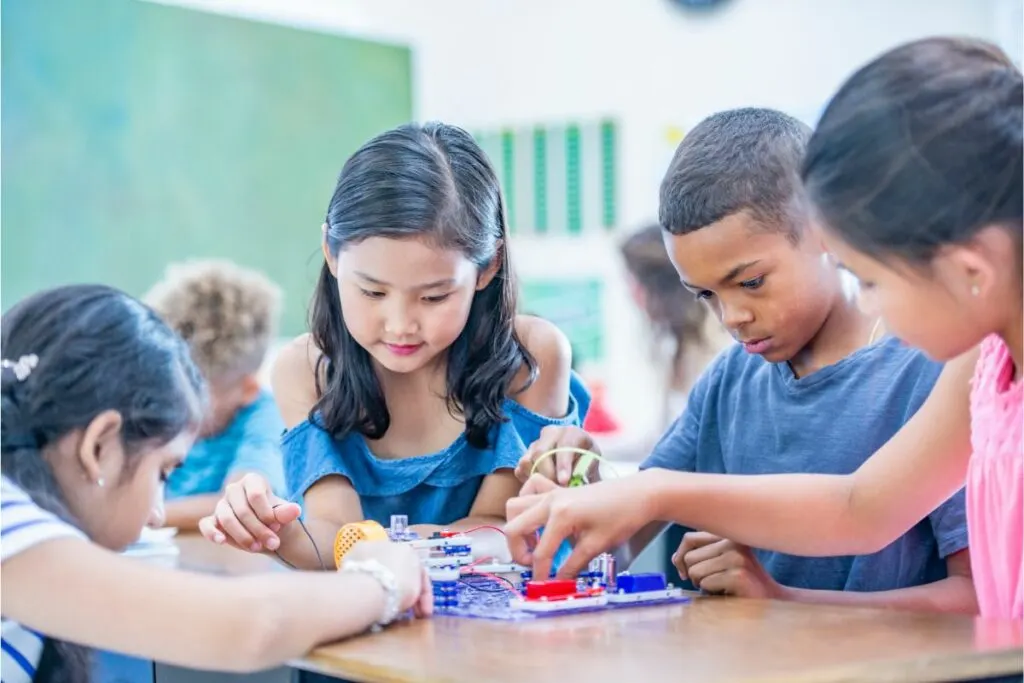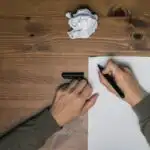Getting middle school kids into STEM can seem like a challenge; however, if you can make their learning fun, you’ll find you have a lot more success.
Kids at this age love hands-on learning that gets them out of their seats and learning by doing instead of listening.

None of these projects take a lot of preparation in order to set up, and they can all be done at home or in the classroom.
We’ve broken our projects down into the different subjects that make up STEM; however, before we get into it, let’s take a quick look at what STEM is and why it matters.
What Is STEM?
STEM is an acronym that stands for Science, Technology, Engineering, and Math. If you want to incorporate some more creativity into your classroom, then you can practice “STEAM” activities, which simply add the Arts.
STEM is an educational policy that helps to address subjects and concepts that can often be overlooked in the classroom.
Whilst it’s easy to incorporate science and math, technology and engineering are vital components to a kid’s learning that they might only be able to access through extra-curricular activities.
By developing a strategy to include STEM and STEAM activities in your classroom or home, you can ensure that your students or children have a more solid understanding of how scientific concepts can be applied in real-world situations.
Using STEM is also a great chance for your kids to work on their problem-solving skills and critical thinking for students, from kindergarten all the way up to high school.
Now that we’ve covered exactly what STEM is and why it’s important, let’s look at ten educational and fun STEM projects that your middle school students will love.
Science
Using different materials and engaging with some key scientific concepts, your students can get involved with their science lessons in a more engaging way than just sitting at their desks and listening for an hour.
1. Solar Oven
Teaching your students how to create a solar oven is not only a practical survival skill but is also a super fun way for kids to learn about how solar heat and solar power work whilst you make something tasty to eat.
Using a small, reflective surface, you can use the power of the sun to heat up a cooking pot enough to cook food!
Top Tips:
- Use a dark-colored cooking pot to maximize heat absorption.
- Cover the cooking pot tightly so that no heat escapes.
- Use your solar oven in an area that gets direct sunlight for most of the day.
2. Sedimentary Rocks Model
If you’ve been teaching your kids about different kinds of rock, then you should give these simple sedimentary rock models a try in your classroom.
By smashing together graham crackers, hard-shelled candy, and mini marshmallows, you can demonstrate how sedimentary rocks are formed.
Use pressure to smash the “rocks” together, which forces the candy and cookie pieces into the marshmallows whilst also melting the marshmallows so that everything sticks together.
This is an interesting (and tasty) way to demonstrate how sedimentary rocks are formed and should help your students retain the information more.
Technology
3. Coding With Scratch
Coding and computer fluency is such an important aspect of our lives now that teaching kids how to program whilst they’re still in school is not only really important but is also something that they’re likely to be interested in.
Most kids play some kind of video game or engage with content online, so there’s going to be something that they want to create.
Using a site like Scratch introduces them to the idea of programming in an easily digestible format and allows them to play around with different coding concepts and see projects that other people or students have made, inspiring them and giving them ideas for their own projects.
4. Smartphone Projector
If you’re trying to figure out what to do with the cardboard overflowing from your recycling bin, then why not give this super easy and super interesting project a try?
Projectors are surprisingly simple bits of technology and one that you can easily recreate in the classroom without much preparation.
In fact, all you need is a small cardboard box (a shoe box is perfect, along with some spare scraps for a phone stand), a magnifying glass, scissors, tape, and, of course, a smartphone.
Putting the pieces together isn’t super complicated and should be a totally age-appropriate challenge for your middle school students.
Engineering
5. Optimized Paper Airplane
Anyone and their grandma can make a paper airplane, but can they make the most optimized and aerodynamic airplane?
There are some really interesting and intricate designs that your students can copy and try to create. Challenge your kids to make the best paper airplane and test them out during class.
See which plane can fly the furthest, the quickest, and whether any are able to do loops.
This gets your students practicing their critical thinking, ability to follow instructions, and their dexterity to actually make the folds.
6. Egg Drop Challenge
This one is a classic. Who hasn’t gone to school and performed an egg drop challenge?
The concept is simple: your students are going to drop an egg from a predetermined height, and their challenge is to create a system that will prevent the egg from breaking.
Some children might try to pad the egg enough to break its fall, whilst others might attempt to slow the egg with a parachute.
Provide your students with some simple materials like paper, tape, and cotton balls for them to make their egg protectors, and let them figure out how they want to save their eggs.
7. Paper Rollercoaster
A lot of classes will get their students to create the best paper bridge. However, we prefer to do something a little different. This paper rollercoaster challenge gets your kids constructing a rollercoaster out of paper.
Admittedly, this project does require a lot more preparation and materials, so it’s best to get your students to work in groups so that you don’t have to bring so many different sets of material to class with you.
There’s a lot of cutting and folding involved, so you might have to lend a hand in some places; however, at the end of the project, your students will be engaged with key scientific concepts like kinetic energy and potential energy.

Maths
8. Geometric Heart
To bring holidays like Valentine’s Day into your math classes, you could try introducing your students to these geometric shape challenges.
This particular set of instructions has you creating a heart. However, you can easily have your kids come up with some new designs that they can create using the same method.
With just string and pipe cleaners, you can create these adorable geometric hearts. Grab straws and pipe cleaners in as many fun colors as you can find to make the craft more interesting.
If your kids want to make their own design, you can make sure that they measure it carefully and calculate how many straws and pipe cleaners they’re going to need.
9. Surface Area Castles
This next craft might run over a couple of days, but it’s so fun and creative that you won’t mind. For this activity, your students will create, measure, and calculate both the surface area and volume of a 3-D model castle that they can then design however they like.
You can pick up the templates for free and encourage your kids to build the best castles they can by making it a competition.
10. 100-Cup Tower
The final activity on our list is another classic. The 100-cup tower challenge is set up to get your kids building the tallest (and steadiest) tower possible using 100-cups.
If that’s a lot of materials that you can’t provide, then why not make it a 10-cup challenge instead>?
You can add complexity by getting your students to measure, record, and compare the heights of each tower.
Whose tower was the tallest? Whose tower was the most structurally sound? Were they the same tower, or was there some difference?
Final Thoughts
Introducing STEM activities to your classroom can be a great way to get your students engaged in activities that are teaching and demonstrating key mathematical and scientific concepts without them even realizing all the time.
Before each craft or project, you should discuss the activity with your kids and get their predictions on what they think will happen.
Talk them through the project, explaining the different concepts that they’ll be exploring, and, most importantly, give them a time limit.
It can be difficult to keep excitable middle school kids on task during open-ended activities, so make sure they have a set deadline that they have to be finished by.
Which of these activities will you try? Happy teaching!
- Homeschooling In High School: Pros And Cons - February 24, 2024
- How Do I Withdraw My Child From School To Homeschool? - February 23, 2024
- How To Not Go Crazy Homeschooling Kids: A Guide For Frazzled Parents - February 22, 2024









Leave a comment